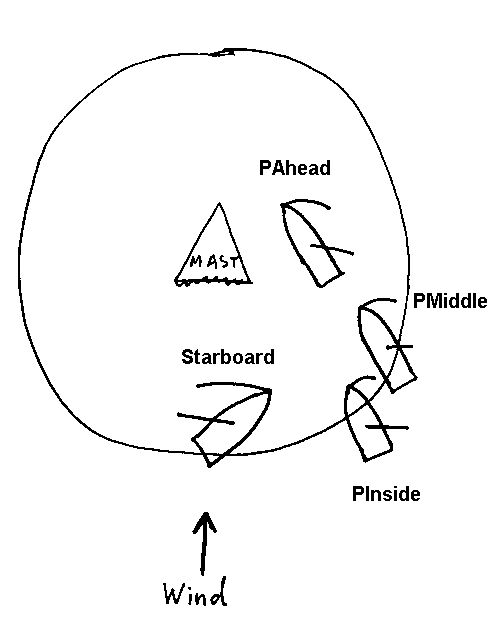Rich Schifreen
Starboard, PInside, PMiddle and PAhead are all approaching a downwind
mark Starboard is on starboard tack just within the two boat length
circle. PInside, PMiddle and PAhead are all on port tack with PInside
and PMiddle overlapped at the two boat length circle and PAhead clear ahead.
In this situation:
A - None of the boats can interfere with PInside because she is overlapped
at the two boat length circle.
B - PMiddle can gain “rounding rights” if she establishes an inside
overlap with PAhead before reaching the mark.
C - Starboard has no rights since she will have to gybe onto port to
round the mark.
D - PMiddle must give PInside room to round, but both boats must yield
to PAhead and Starboard.
See the answer below:
This is the kind of mess we might typically see on a Friday night race. There are a lot of boats and things happen fast. The rules can be complicated, but lets sort it out. We’ll start with PInside and PMiddle that are on the same tack and overlapped at the two-boat length circle. Rule 18 applies as boats approach a mark until they pass it. Lets look at rule 18.2:
18.2 Giving Room; Keeping Clear
(a) When boats are overlapped before one of them reaches the two-length
zone, if the outside boat has right of way she shall give the inside boat
room to pass the mark or obstruction, or if the inside boat has right of
way the outside boat shall keep clear. If they are still overlapped when
one of them reaches the two-length zone, the outside boat's obligation
continues even if the overlap is broken later. This rule does not apply
if the outside boat is unable to give room when the overlap begins.
(b) If a boat is clear ahead when she reaches the two-length zone,
the boat clear astern shall keep clear even if an overlap is established
later. Rule 10 does not apply. If the boat clear ahead tacks, rule 13 applies
and this rule no longer does.
(c) If there is reasonable doubt that a boat established or broke an
overlap in time, it shall be presumed that she did not.
Rule 18.2(a) requires that PMiddle give PInside room to round the mark. PMiddle temporarily loses some of her Rule 11 rights as leeward vessel. The situation between PAhead, PMiddle and PInside is also covered, in this case by 18.2(b). PAhead was clear ahead at the two boat length circle and therefore PMiddle and PInside must keep clear even if they establish an overlap before the mark. Note that PMiddle’s obligation to stay clear of PAhead overrides her obligation to provide room for PInside should the two come into conflict.
We now need to consider the case of Starboard. Lets look at Rule 10:
10 ON OPPOSITE TACKS
When boats are on opposite tacks, a port-tack boat shall keep clear
of a starboard-tack boat.
Note that Rule 10 applies in the case of 18.2(a), but not 18.2(b).
Starboard was overlapped with PInside and PMiddle at the two-boat length
circle, so 18.2(a) and 10 both apply. Both boats must stay clear
of Starboard. In the case of PAhead and Starboard, Rule 18.2(b) applies
and Rule 10 does not. Starboard must stay clear of PAhead until they
pass the mark.
Choice D is correct. Note that there is no benefit to gaining
an overlap once within the two-boat length circle.
This all sounds very complex, but you can sort it out quickly
with a simple guide:
- A boat clear ahead at the two-boat length circle will always have
rights.
- A starboard tack boat will have rights over port tack boats that
are not clear ahead.
- When two boats on the same tack are overlapped at the two-boat length
circle, the inside boat will be entitled to room to pass the mark.
- The special conditions of Rule 18 end as soon as the boats pass the
mark and leave it astern.
If you have a rules situation that you'd like to see covered in
the quizzes, send an e-mail to mast_yc@geocities.com
There's a wealth of information on the racing rules at Art Engel's site
http://www.racingrules.org/
including a rules guide and some additional quizzes. A current rules book
is included as part of membership in U.S. Sailing – check for membership
information at http://www.ussailing.org
The rules are posted on the International Sailing Federation Web site at
http://www.sailing.org
